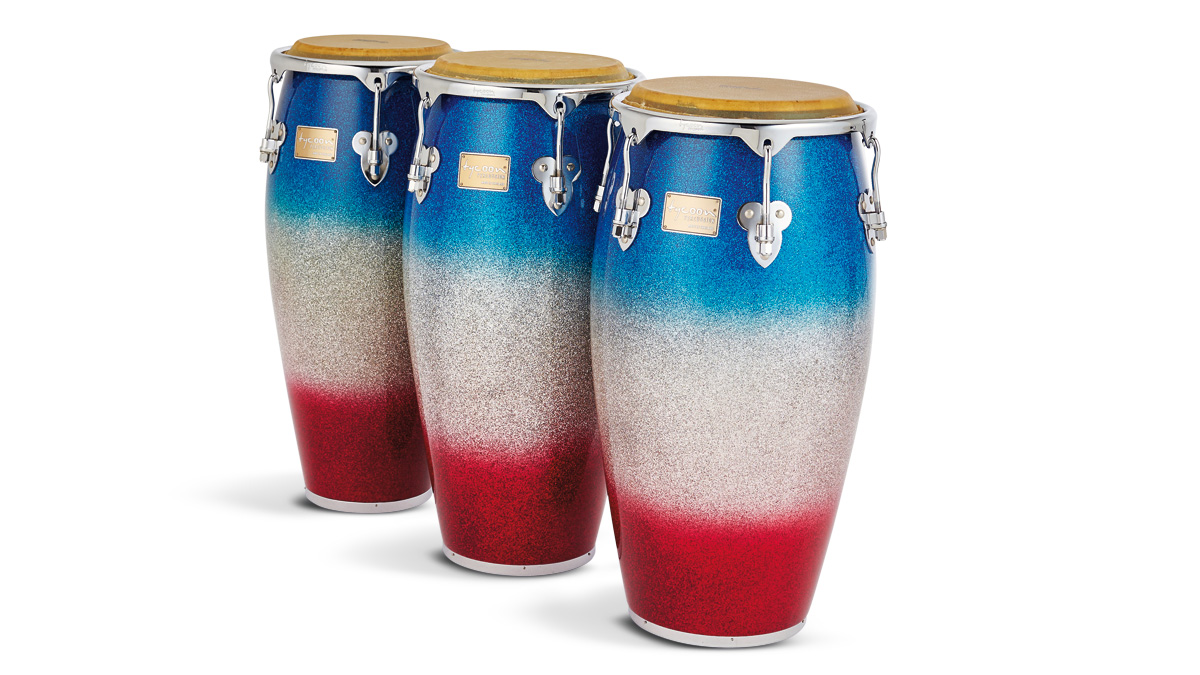MusicRadar Verdict
These Tycoon congas are big, imposing and authentic sounding - in the right hands, truly inspirational percussion instruments.
Pros
- +
Well made.
Cons
- -
Expensive.
MusicRadar's got your back
Last year we checked out three superb cajons from eco-friendly percussion producers Tycoon. Now into their 32nd year, their range just gets bigger, bolder and a whole lot more comprehensive with percussion products encompassing everything from cajons to congas, djembes to dancing drums and a mass of accessories.
Build
Percussion goodies this month comprise a set of three congas from Tycoon's Master series. Congas or tumbadoras (as they are known in Cuba), have been popularised with the name 'conga' primarily due to the dance rhythm provided by the distinctive Cuban pulse.
"Tycoon congas are made from a sizeably bulky 'hand-selected' Siam oak in staved slices, in a similar fashion to wooden beer barrels."
There are actually three main types of congas and not just one, as is often mistaken. The smallest here is the 11" Quinto (often used as the leading drum), while the other two members of this triple ensemble is the 13" bass Tumba, sited at the low end, and sited in the middle is the 12"-diameter Tres Dos.
Each drum is finished in platinum tri-fade which sports a translucent blue/silver/red spray paintwork and a layer of silver sparkle. Due to the apparent thickness, this has all the appearance of a wrap but without the ugly seam. The whole effect is created by a plasticised base encapsulating shiny particles with the gradual colour fades finished in a high-gloss lacquer.
All three congas come with their own stand featuring a substantial chromed steel ring and three height-adjustable legs. Topped by a chunky slice of a pimply rubber, the legs have a rubber foot and the whole drum is supported by a steel rim held aloft by the three legs. The weight of the drum holds it in place and, while it's possible to tilt the congas to a degree, within those rubber grips, the legs can also be adjusted to angle the drums significantly if required.
Head tension is provided by a hefty upside-down 'question mark'-shaped bolt made from 3/8" diameter steel. The chromed steel rim is equally substantial and able to withstand the physical forces from those large bolts and a percussionist's performance. The tuning is via 13mm (approximately 1⁄2") nuts and a spanner is provided with each conga for tuning.
Tycoon congas are made from a sizeably bulky 'hand-selected' Siam oak in staved slices, in a similar fashion to wooden beer barrels. The name of the woody material is quite misleading as the trees they are made from are not actually 'oak', as we would imagine.
Want all the hottest music and gear news, reviews, deals, features and more, direct to your inbox? Sign up here.
Rather they are made from the wood of the rubber tree, grown for the rubbery sap and which, once they no longer produce their bounty of the sticky liquid, are used in various furniture and musical applications. This is an amazing sustainable source, plentiful in Thailand and fitting in nicely with Tycoon's eco ethos. Compared to their lighter fibreglass cousins, these wooden congas are surprisingly heavy.
Hands On
We have taken the pitch interval as near to a perfect fourth as possible - the first two notes of 'Here Comes the Bride' could be used as a guide. With all three congas at our disposal, this seems the optimum to create those tasty rhythms and maintain musicality.
"Performing, even with my slightly flaky conga technique, manages to achieve those familiar conga sounds and tones, demonstrating more than just a hint of what each model is capable."
Having been used to plastic heads over years of playing, it does seem a little odd going back to real skin - having to make sure the drums are detuned after each performance and keeping a close eye on the weather. If they are left too taut and we hit a spell of dry weather, the skin rapidly loses moisture, tightening up, and can raise in pitch significantly, prematurely reducing their playable lifespan.
Of course, conversely, if there is a lot of humidity in air or it's just good old British weather, miserable and wet, the heads will absorb the moisture and become slack.
Performing, even with my slightly flaky conga technique, manages to achieve those familiar conga sounds and tones, demonstrating more than just a hint of what each model is capable. Closed/muted, bass or
open, each slap produces a pleasing tone and, if left to sustain, a mouth watering overtone too.
Introducing a cupped palm, fist, individual fingers, and at times even elbows for a far-reaching pitch bend, coaxes the thick buffalo skin heads into providing us with a range of rich, varied sounds and timbres.
Though real heads with wooden congas don't provide such a cutting slap as fibreglass, striking the centre of the head with a full-on palm causes the Tumba to generate a lush, deep bass sound which appears to be richer than a similarly sized conga. When playing either of the other two models it doesn't appear to have quite the sharp attack when aiming for a snappy slap at those higher pitches.
The 13" is great for those lower tones, producing an effortless virtual sub-bass - think of the conga pattern with its deep bass part at the beginning of The Eagles' 'Hotel California' from the live album Hell Freezes Over - yes, this is possibly kick drum territory.
